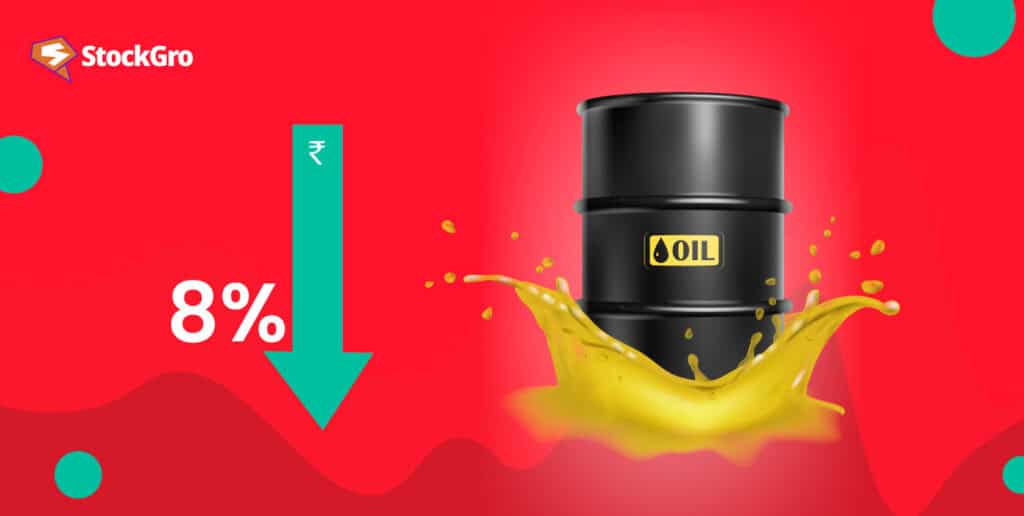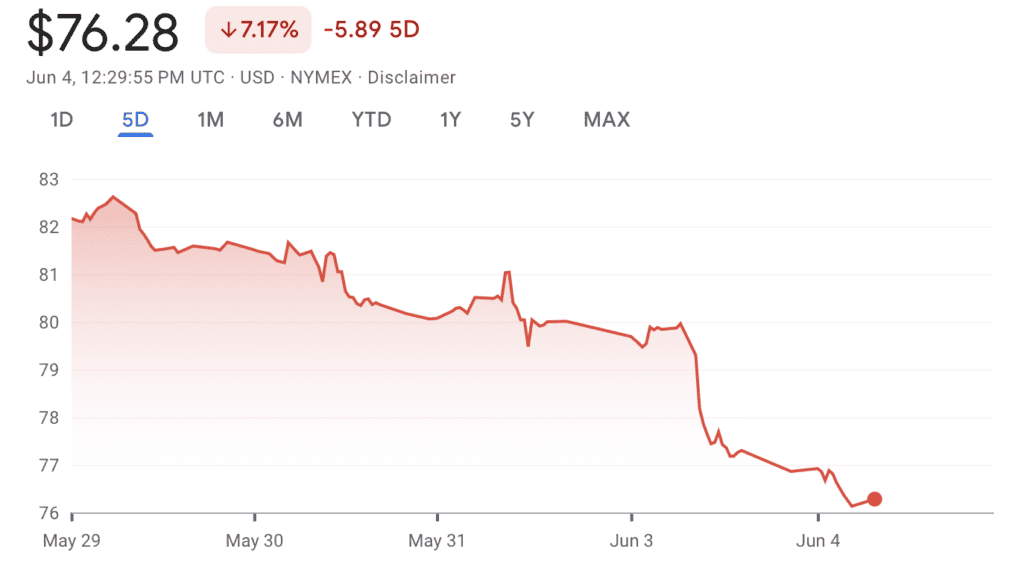
On June 4, 2024, crude oil prices dropped around 8% in early trade, continuing their losses from the previous session. This decline saw prices hitting their lowest point in four months.
Why did crude oil prices drop? What is the crude oil price drop reason? For detailed insights, check out our latest blog.
Understanding crude oil prices
Crude oil pricing is influenced by various global factors.
- Supply & demand: It is essentially a matter of supply and demand harmony. Prices decrease when supply is greater than demand, and prices increase when supply is less. Several internal and external elements can influence this dynamic in various nations.
- Oil futures market: Another key aspect is the oil futures market. Here, buyers and sellers agree on a price for crude oil to be delivered at a future date. This market influences current prices as traders speculate on future supply and demand. Futures contracts are essential for hedgers and speculators, impacting overall market stability.
- Crude oil quality: Crude oil quality also affects pricing. Lighter, sweeter crude, which is easier to refine, commands higher prices compared to heavier, sour crude.
These variations, coupled with geopolitical events, production levels, and economic indicators, create a complex pricing environment that constantly shifts in response to global developments.
But why did crude oil price drop today? First, let’s check the number behind the drop.
You may also like: Fueling India’s growth engine: Evolution and outlook of oil & gas industry
Crude oil price drop
Over just five sessions, prices have dropped nearly 8%, hitting a four-month low. Brent crude futures fell sharply from $83.94 per barrel to around $76.28 on June 4, 2024 session.

Similarly, U.S. West Texas Intermediate (WTI) crude also tumbled, reflecting a similar downward trend. This rapid decrease has marked a notable shift in the oil market, bringing prices to their lowest level in months.
Also read: Everything you need to know about Crude oil trading in India
Why is the crude oil price dropping?
Here are the major reasons for the crude oil price drop:
Easing production cuts
The Organisation of the Petroleum Exporting Countries (OPEC+), led by Russia, is a group of countries that together hold production cuts of about 5.8 million barrels per day. This accounts for approximately 6% of global oil supplies.
These cuts were agreed upon by OPEC+ nations as a measure to support oil prices by restricting supply in the market. OPEC+ hopes to keep the balance between supply and demand by lowering their combined output, which will keep the price of crude oil from plunging too far.
OPEC+ agreed to extend most of their existing oil output cuts until Q3 2024. However, they also outlined a plan to gradually phase out these cuts over the next 12 months.
Easing production cuts means that oil-producing countries are starting to produce more oil after a period of reduced output. By easing these cuts, more oil will enter the market, potentially lowering prices due to increased supply.
From October 2024 onwards, voluntary cuts of 2.2 million barrels per day will be reduced. By December 2024, an additional 500,000 barrels per day are expected to re-enter the market.
By June 2025, a total of 1.8 million barrels per day will be added back to global supply. This decision aims to balance supporting oil prices while addressing pressure from some members for higher output levels.
While OPEC+ continues to reassure markets of their commitment to price support, the gradual supply increase indicates that extreme levels of market intervention may not persist indefinitely.
Weakening demand outlook
Compounding the supply worries are signs of weakening demand, particularly from the United States, a major oil consumer. Recent economic data pointed to a slowdown in U.S. manufacturing activity for the second month and a surprise drop in construction spending for two consecutive months.
The ISM manufacturing index in the US showed contraction for a second straight month in May, falling short of the anticipated 49.5 points and to 48.7 from 49.2 in April. New Orders dropped significantly as well, from 49.1 to 45.4.
The U.S. Energy Information Administration (EIA) will make public its forecasts for fuel use and oil stockpiles on Wednesday, June 5, 2024. This information will help to clarify how much gasoline was used during the Memorial Day weekend, which officially kicks off the driving season in the United States.
The report acts as a proxy for demand and will signal the strength of gasoline demand during the peak summer driving period. Lower consumption could point to a weakening demand outlook. Data says the average gasoline price in the USA fell by 5.8 cents per gallon to $3.50 per gallon on June 3, 2024.
Such indicators suggest a potential decrease in fuel consumption, further dampening the demand outlook for crude oil.
Global growth concerns
Adding to the bearish sentiment are broader concerns about slowing global economic growth. Fears of a deceleration in key markets like China and Europe have raised doubts about future oil demand growth.
Recent signs of de-escalation of risk premiums have led to a 12% correction in oil prices over the last two months. This setback for crude oil is closely tied to weak performance in emerging markets.
A slowdown in the second-largest economy in the world was reflected in the official Chinese Purchasing Managers’ Index (PMI) data for the manufacturing sector, which projected a decline. Meanwhile, Eurozone manufacturing has similarly faltered in the last two months, exacerbating concerns about global industrial activity.
As economic activity cools across these major markets, energy requirements are likely to moderate, putting additional downward pressure on crude prices. This global slowdown suggests a challenging outlook for oil demand growth, further influencing the market dynamics.
Also read: ONGC’s Q4 Results: Highest-ever net profit and dividend payout
Bottomline
The recent decline in crude oil prices highlights the complex interplay of supply, demand, and economic factors. As markets adjust to these dynamics, keeping informed about such shifts is crucial for understanding future price trends.

